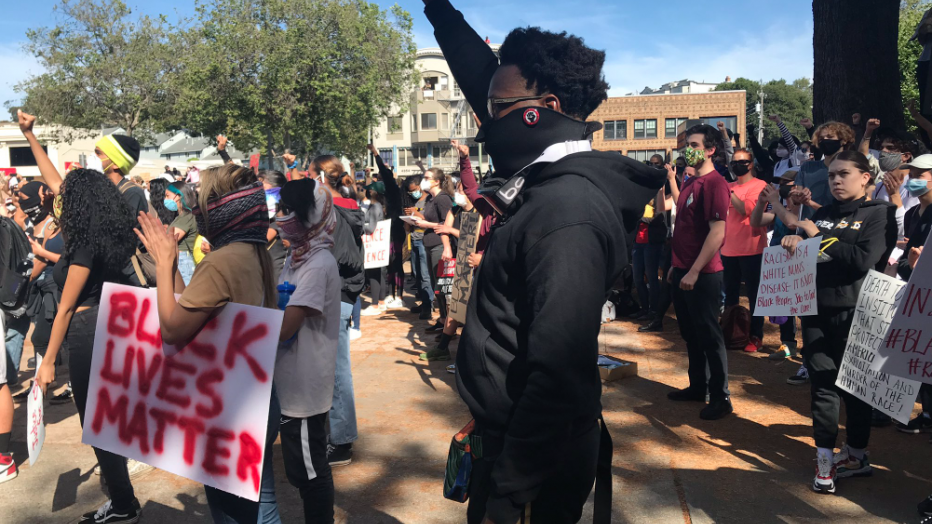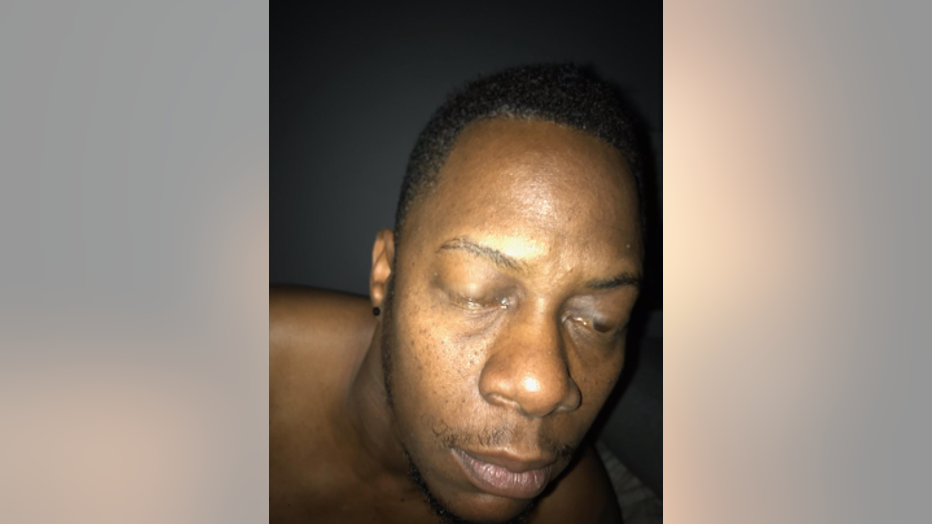Oakland police chief apologizes; issues 33 disciplinary actions for using tear gas against protesters
OAKLAND, Calif. - Oakland Police Chief LeRonne Armstrong on Wednesday for the first time apologized for what happened at a youth-led George Floyd protest last summer and he also announced that he has issued more than 33 disciplinary actions to officers for using tear gas, in violation of department and city policy.
Despite a police narrative that has lingered over Oakland for a year, there was no imminent threat to officers or to the public on June 1, 2020, Armstrong said. And using tear gas under these non-threatening circumstances goes against code and court order.

A young man holds his fist up to the sky at an Oakland Tech rally to mourn the death of George Floyd. June 1, 2020
"We failed on June 1," Armstrong said in a one-on-one interview with KTVU ahead of a news conference. "We deployed tear gas outside policy. I apologize to the young people that you had to experience what you experienced. This department is holding itself accountable."
Without identifying anyone by name, Armstrong said that the officers, which included top command staff all the way up to deputy chief, faced written reprimands to suspensions. No one was fired. He would not specify how many officers received the disciplinary notices, but did say that some people received more than one. In an interview, Mayor Libby Schaaf said it was "more than two dozen officers."
Armstrong was one of the deputy chiefs at the time. He said he was not disciplined.
And for the first time, Armstrong admitted that there was no evidence of Molotov cocktails being thrown at police headquarters just before curfew that evening, as he first had told the public. He also acknowledged that there were indeed young people and seniors in the crowd, even though he originally said there weren't.
"I apologize to the community," he said.
Those pieces of unvetted information came from radio traffic, he said. And all evidence now points to the fact that one water bottle had been thrown over a police barricade, which set the tear gas and less-than-lethal projectiles in motion.
KTVU first reported witness accounts that disputed the police narrative within a week of the protests, where dozens say they were injured, bruised and temporarily blinded from the toxic chemicals and the equivalent of rubber bullets.

Toshua Sears was injured after getting tear gassed at an Oakland youth rally in honor of George Floyd on June 1, 2020.
"That's been one of the most difficult lessons of this," Armstrong said. "The community said that wasn't true and I listened to what they said."
The lesson he learned is that he said the department needs to better vet information before officers share it with the public.
As for why it took Armstrong one year and one day to apologize and tell the public about the discipline?
"It's not about the time it takes," Armstrong said. "It's about getting it right."
But Samuel Getachew, 18, an Oakland Tech graduate who is headed for Yale University and who ran from the tear gas that night said it is about how long it takes.
"Over a year later, it feels like the only reason there is this admission of fault is because of public pressure," he said. "People for a year kept insisting and making noise. That's not something a community should have to do to keep their public servants accountable."
And Jennifer Li, a protester who got struck by a stun grenade that perforated her eardrum said Armstrong's words come late, but she thought it was good he was trying to restore a relationship with the community.
"This is good," she said. "But the bar for policing is so low. This is surprising. But I'm glad he said it."
Armstrong said he wanted to take his time as his staff had to wade through as many as 300 complaints of force and fully investigate the facts. And there were four nights of protests they had to review. The youth-led protest followed three nights of undeniably violent and chaotic evenings.
- On May 29, Molotov cocktails were thrown and a federal agent was killed by a member of the far-right Boogaloo movement.
- On May 30, there was looting in Oakland and neighboring Emeryville.
- On May 31, there were "crime caravans" breaking into marijuana dispensaries, Walgreens and small businesses along International Boulevard.
And so officers were on edge and exhausted when the youth-led rally occurred on the fourth night of protests.
"That took an enormous amount of time," he said.
Even before the investigations by his command staff, the Oakland Police Commission and an independent firm were complete, Armstrong said he began to make changes.
From now on, Armstrong said that officers rotate their schedules so that they don't work so many consecutive nights.
In addition, Armstrong admitted there were "failures in mutual aid" on June 1, 2020, and he promised to take more control of these situations that need outside agency help. Many criticized the heavy-handed tactics of some Alameda County Sheriff's deputies, who had written the interim police chief at the time that they wouldn't help out unless they had the ability to use tear gas.
Armstrong also said that he will now also grant a fewer number of people the authority to deploy tear gas. In fact, supervisors will be told to oversee what's going on, instead of being the actual ones to use the gas.
And Rachel Lederman, a civil rights attorney who helped write Oakland's tear gas policy more than a decade ago, said that she thought it was nice that the chief acknowledged that June 1st was a failure for OPD but he is minimizing some important facts."
She said many of the changes he's proposing have already been written into policy.
Ahead of the news conference, Mayor Schaaf told KTVU that "Oaklanders deserve no less" than a full accounting of what happened.
SEE ALSO: Oakland police officers disciplined following deployment of tear gas at summer George Floyd protests
When pressed, however, Schaaf acknowledged that "the law will probably prevent" the chief from identifying the officers who received discipline by name.
The law SB 1421 mandates the public release of information, including officers' names, when they cause great bodily injury. Several people have said they were injured on that night with pellets and toxic chemicals. But it remains to be seen how the city attorney will interpret the extent of those injuries, which have been detailed in at least two federal lawsuits.
At the news conference, Armstrong said he was thankful there were no serious injuries to protesters.
A new police transparency law by State Sen. Nancy Skinner, SB 16, would require the release of all use of force records regardless of injuries.
Armstrong told KTVU that he was planning on preparing an "after-action report" and make that public to the Oakland Police Commission at some point in the future, which may have some more details about what transpired, the specific violations that were incurred and the discipline meted out.
KTVU has filed multiple California Public Records Requests seeking this information over the last year.
Armstrong said that while that date last summer is not a proud one for Oakland police, the self-assessment has only made the department stronger.
He said he wants Oakland, where he grew up, to be a city that embraces social justice activism and where people can feel safe expressing their First Amendment rights.
"We'll do better," he promised.
Lisa Fernandez is a reporter for KTVU. Email Lisa at lisa.fernandez@foxtv.com or call her at 510-874-0139. Or follow her on Twitter @ljfernandez
Evan Sernoffsky is an investigative reporter for KTVU. Email Evan at evan.sernoffsky@foxtv.com and follow him on Twitter @EvanSernoffsky

